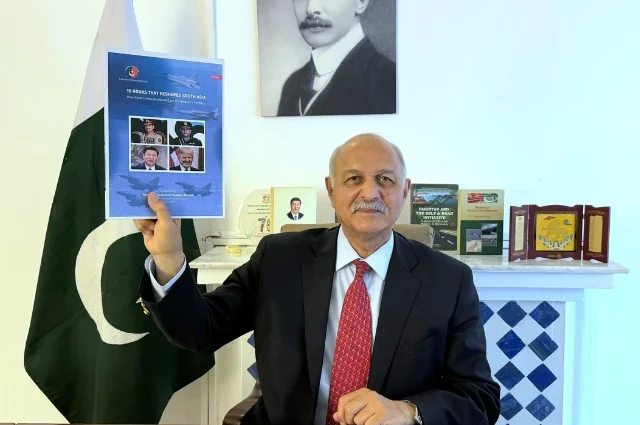ISLAMABAD ( WEB NEWS )
The Pakistan Air Force’s electronic warfare and cyber capabilities were identified as a decisive factor. The PCI report analyses the regional implications of the conflict that followed the April 22 terror attack in Pehelgam, tracing events through to the eventual ceasefire.
The report also draws historical parallels, comparing Modi’s decision-making to other infamous strategic errors, including Hitler’s 1941 invasion of the Soviet Union.
According to PCI, Pakistan’s armed forces, under the leadership of Field Marshal Syed Asim Munir and Air Chief Marshal Zaheer Ahmed Babar, responded with flawless inter-service coordination and strategic clarity.
Mushihid Hussain praised the military’s use of sophisticated technology, including electronic warfare tools, claiming Pakistan achieved cyber supremacy during the confrontation. He also highlighted the role of the Pakistan Air Force (PAF), crediting their professionalism, training, and operational skill as vital to the successful response.
The report’s cover, featuring images of JF-17 Thunder and J-10C fighter jets, symbolises Pakistan’s advanced military capabilities. It also underlines China’s pivotal support, noting that under President Xi Jinping, Beijing stood by Pakistan “like a solid rock”.
The United States also received praise. Hussain credited President Donald Trump with brokering the ceasefire and helping revive the Kashmir issue on the international stage, which the report described as a blow to India’s diplomatic standing.
According to PCI, the conflict produced three lasting strategic outcomes: Pakistan’s restoration of deterrence, China’s emergence as a de facto party to the Kashmir dispute, and the United States’ role as a peace stabiliser in South Asia.
The think tank recommends a comprehensive strategic approach based on three pillars: proactive regional diplomacy, “creative lawfare” on issues like the Indus Waters Treaty, and global narrative shaping through think tanks, media, and diplomatic engagement.
The report also draws historical parallels, comparing Modi’s decision-making to other infamous strategic errors, including Hitler’s 1941 invasion of the Soviet Union.
Senator Hussain concluded with a warning: despite the absence of imminent war, India is still pursuing what PCI terms a “3-D strategy” — to demonise, damage, and destabilise Pakistan. He urged vigilance, national unity, and a healing of political divisions to counter these threats and preserve the morale and cohesion demonstrated during the conflict.
“This episode has strengthened national self-confidence and revived public pride in the future of Pakistan,” he said.
The report includes a detailed timeline of events, international reactions, and assessments of how coordinated responses and popular support contributed to Pakistan’s strategic
Key Points of the Report
-
The victory of May 10 has been described as Pakistan’s most glorious moment.
-
Pakistan-India war deemed unlikely; nuclear balance of terror has deterred aggression.
-
A 3-point strategy is outlined: proactive diplomacy, strengthening alliances, and creative legal action.
-
Recommendation to include China, Türkiye, Azerbaijan, Iran, and Saudi Arabia in an overlapping alliance structure.
-
Proposal to challenge the RSS Hindutva ideology in Western courts.
-
A creative legal approach suggested for the Indus Waters Treaty, including the formation of a joint task force of water experts.
-
A detailed timeline from April 22 to May 24 highlights the role of U.S. back-channel diplomacy and the OIC.
-
The Pakistan Air Force’s electronic warfare and cyber capabilities were identified as a decisive factor.
-
China has been described as a de facto third party in the Kashmir issue.

